Figure 1. Example for a field segment with low monitor units (18 MU) located at the edge of the PTV.
The segment is so small that the tumour may move completely outside in the respiratory phase (at the most cranial position). Due to the short irradiation time, this segment might hence miss the tumour. If this effect becomes significant for a number of fields, the dose distribution shown in Movie 2 is no longer valid, since it is based on the assumption that all respiratory phases will experience the same beam/segment configuration. More realistically, the low-MU segments will only be experienced by some respiratory phases. If the “wrong” phases are associated with the segments, the dose associated with these segments will not contribute to the PTV dose, but still increase the dose to organs at risk.

